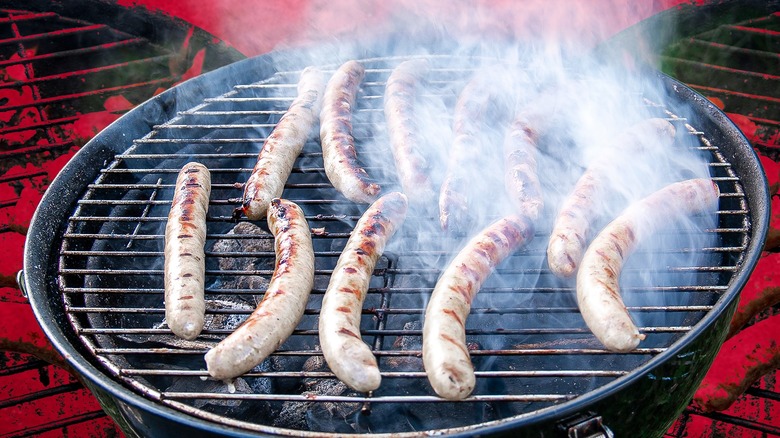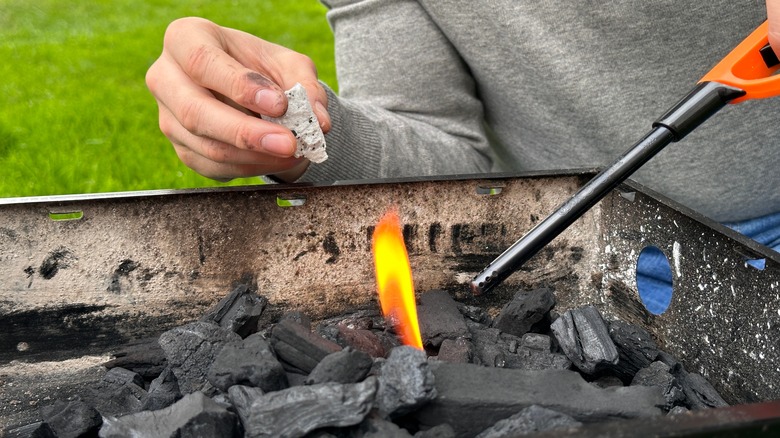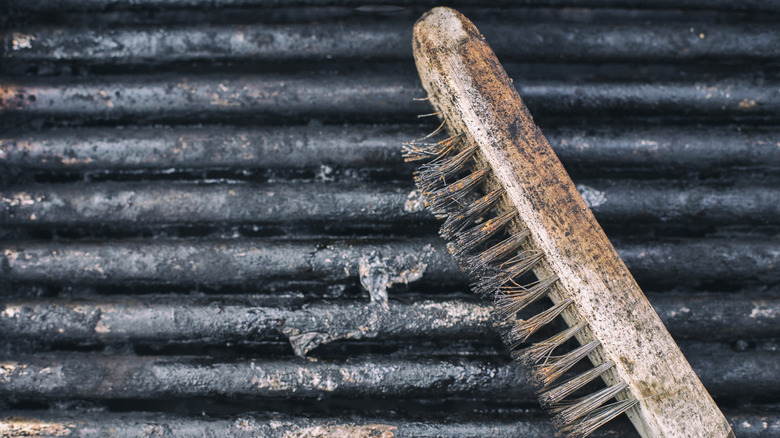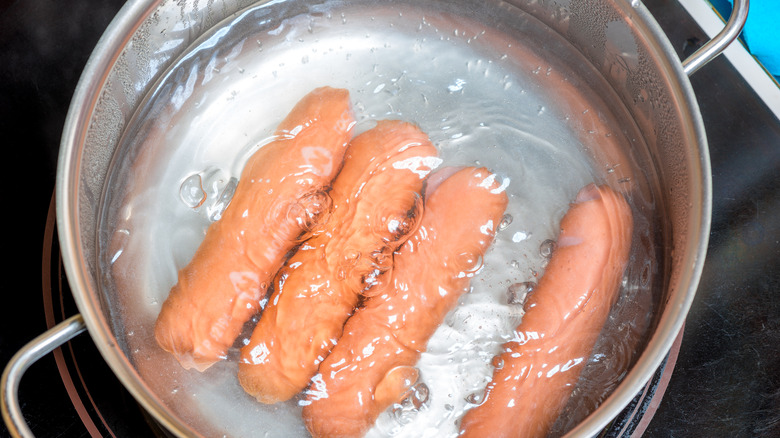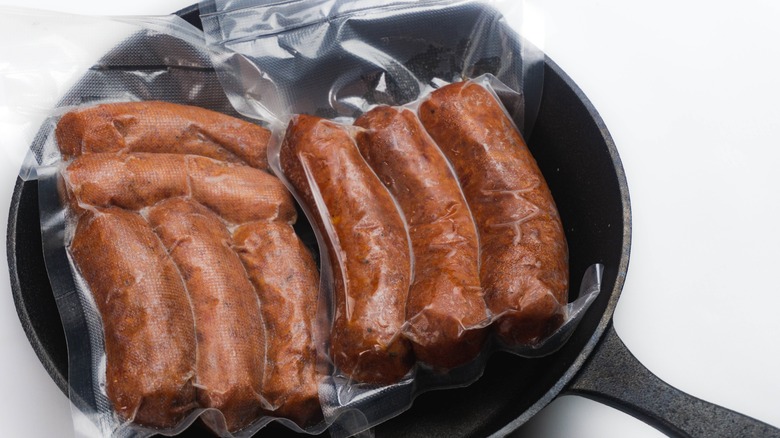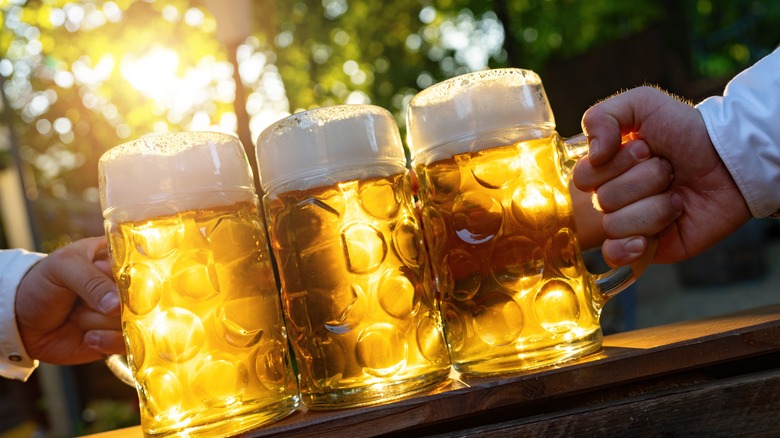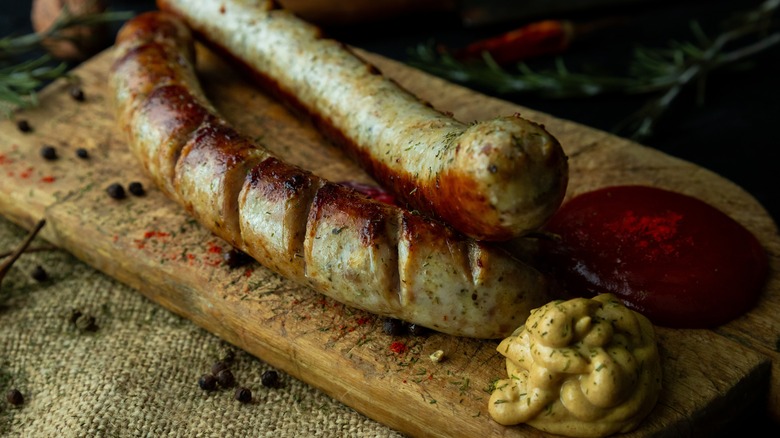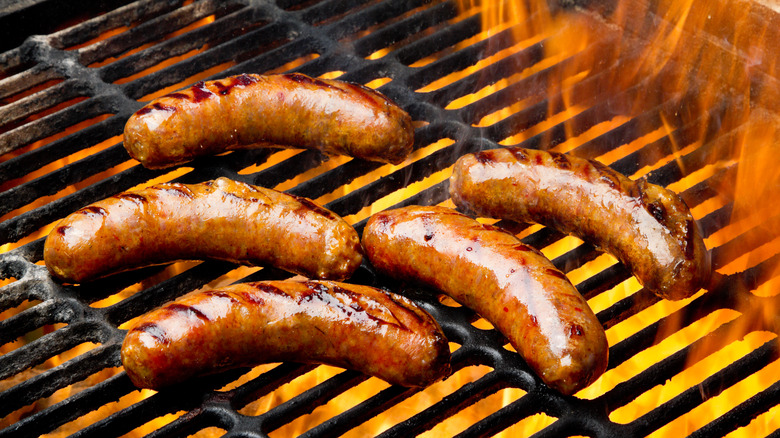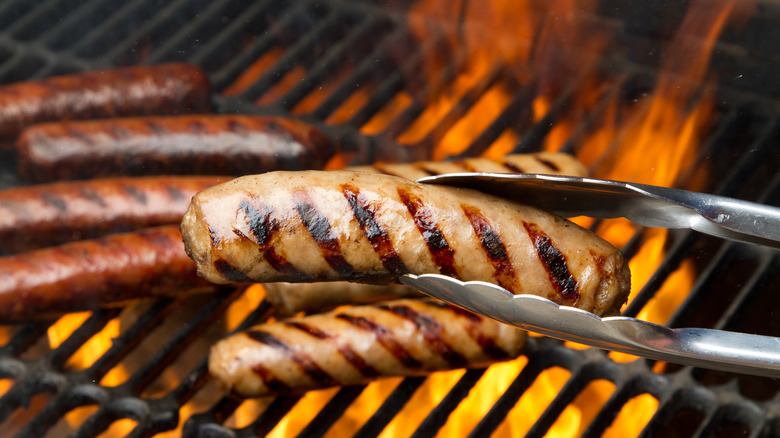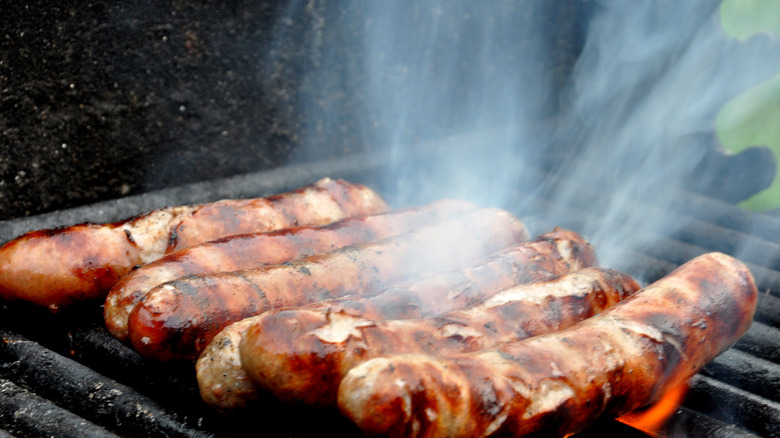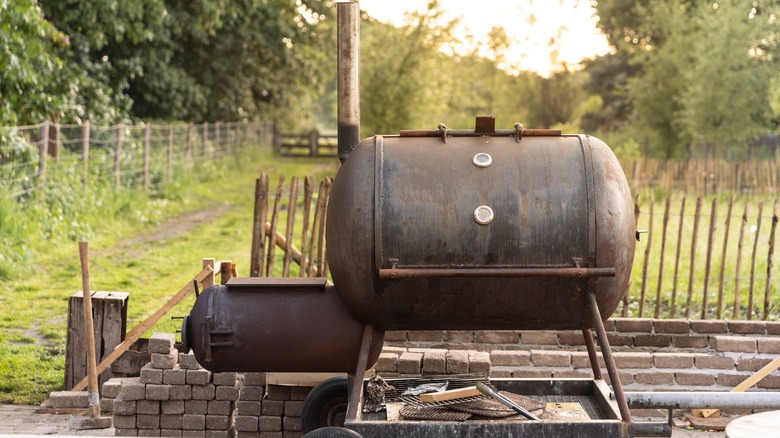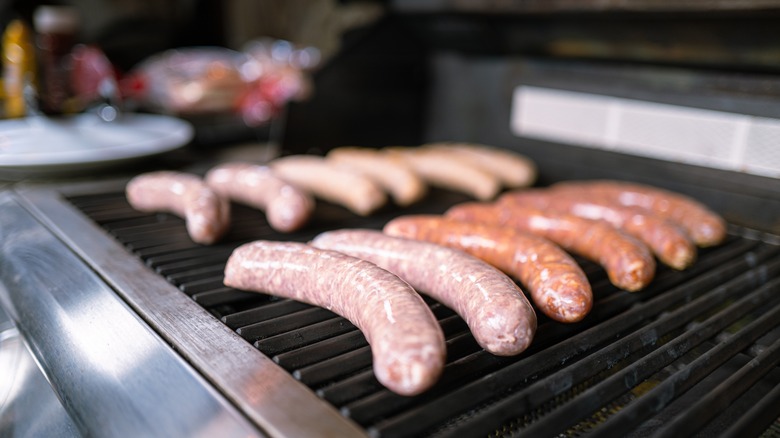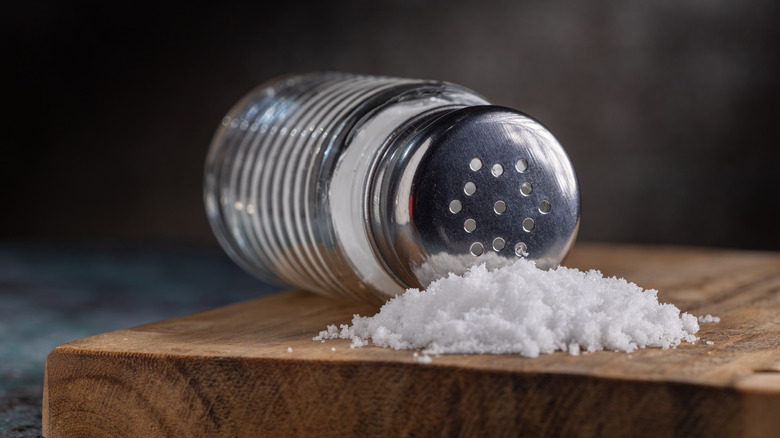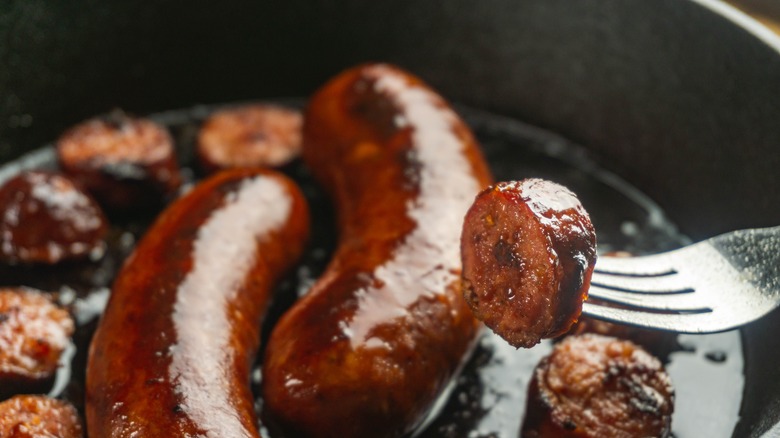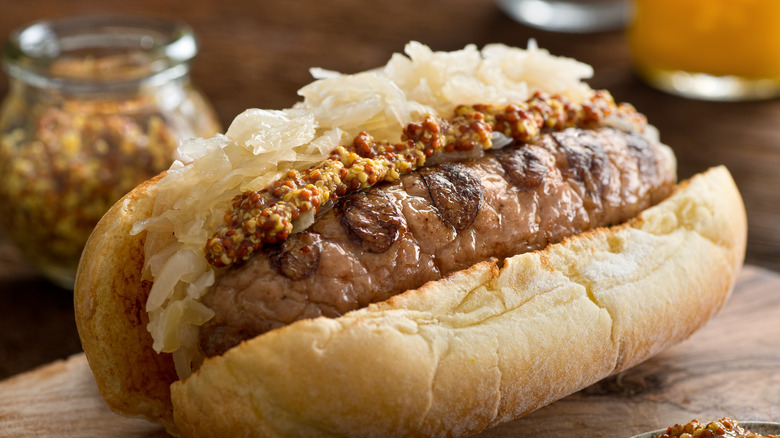14 Mistakes You Need To Avoid When Grilling Bratwurst, According To The Pros
Summer is the season for grilling — there's no doubt about it. And while the starlight is often on the hamburgers and the hot dogs, we think the attention should be shifted towards an even more flavorful option: the bratwurst. And before you even ask — no, they are not the same thing as hot dogs. German bratwurst comes in many different regional varieties, but generally speaking, they're made with a medley of pork, beef, and/or veal and have a little more of a fatty, gristly sausage bite than a ho-hum hot dog. The divine texture and juiciness of this sausage makes it an excellent filling for a sandwich, especially when it's covered with tantalizing toppings like sauerkraut, mustard, and onions.
If you're adventuring outside of the traditional grilling menu and adding bratwurst to your barbecue itinerary, you'll need to read up on how to correctly cook this sausage to optimize its succulent texture and meaty, satisfying flavor. Luckily, we've consulted several grilling and brat experts on how to best grill these sausages, including Weber grill master Jason Pruitt, owner of Lottie's Meats Chelsey Maschoff, professional barbecuer Melissa Cookston, and Eric Rowse, lead chef-instructor of culinary arts at the Institute of Culinary Education in Los Angeles. Fire away!
1. Using the wrong type of fire starter for your grill
The exact method you use to start your grill will really depend on the style of grill that you're using. But regardless of what you're cooking your brats on (charcoal or gas), you'll want to play it safe and ensure that whatever you plan on using is safe to ingest. "Skip the lighter fluid and bring a charcoal starter, or use fire starters," recommends professional barbecuer Melissa Cookston. Using lighter fluid to start your fire can pose several negative health effects and also impart a synthetic-tasting aftertaste to your brats.
If you're a beginner, you may opt to use a chimney starter to get your charcoal grill going. The shape of this tool maximizes the air circulation and results in a sublime heat, which is perfect for firing up a grill with. "You don't need a roaring inferno to get charcoal going, and you sure don't need your food to taste like petroleum," Cookston says.
2. Not properly cleaning off your grill before you start cooking
Say it with us: A clean grill is a well-functioning grill. Although you might not consider it a proper step of cooking, having a clean space to cook your brats is really important. If you neglect to properly clean your grill in between cooking food, you'll run the risk of your brats taking on the taste of your old chicken marinade — which is as unappealing as it is unsafe. Moreover, if you're working with a grill that's particularly dirty, you may find that it doesn't heat up as efficiently and won't give you as consistent of a cook as one that has been properly cleaned beforehand.
"If the grill wasn't properly cleaned after the last grill session, get it hot and scrape the grates with a grill brush, scraper, or other grill scraping tool," says Eric Rowse, lead chef-instructor of culinary arts at the Institute of Culinary Education's Los Angeles campus. "Wipe it down with a clean, damp rag to remove any soot. Then, using a lightly oiled rag, wipe down the grill to season it."
This oil will help prevent the sausages from sticking and make them easier to maneuver. Alternatively, you can also oil your food rather than the grill to reap the fat's non-stick properties and help your seasonings better adhere to your brats.
3. Forgetting to poach your bratwurst first
Although this is indeed a piece about how to grill delicious brats, there are some intermediary steps thrown in there that will give you flavorful brats every single time. The trick to making these finnicky sausages is not to just toss them on the grill — you have to take them for a little swim first. Chelsey Maschoff, owner of Lottie's Meats, recommends poaching the brats before grilling them in a pan for about four minutes on each side. "We find it keeps the brats juicy and provides the best snap," she explains.
Jason Pruitt, grill master at Weber, suggests using par-cooked sausages or braising the raw ones before tossing them on the grill. He notes that the sausages that have been already par-cooked in the liquid can be quickly seared on the grill before being served. Pruitt shares that this finishing step will give you "added flavor and a great crispy crust." You'll also want to be careful not to overcook your sausage, as it could render it too rubbery.
4. Cooking frozen meat
We've all heard the old adage: "There's nothing more productive than the last minute." If you forgot to pull your pack of brats out of the freezer, you may be frantically scanning around your kitchen looking for a way to bring them up to temperature so that you can fire them on the grill just before your barbecue guests arrive. You might ask yourself, "What could go wrong if I just cook them from frozen?" The long and short of it is simple — a lot.
Generally speaking, cooking sausage from frozen is safe, so long as you get a safe internal temperature reading of 160 F. However, cooking anything on the flame straight from frozen opens up the opportunity for inconsistent temperatures, which can be a challenge for a grilling novice. Luckily, tossing your sausages in boiling water before you put them on the grill will help ensure that they are perfectly thawed throughout and ready to cook with.
5. Only boiling your brats in water
Water is a go-to for boiling brats, but it's far from the only liquid that can make these sausages delicious. Your favorite beer will add a ton of flavor to the meat, and it might even give you an excuse to use up the opened can you forgot about on your counter. The exact time that you should simmer your brats in a brew depends on the amount of time recommended in the recipe. Chelsey Maschoff suggests just a few minutes, while other recipes will recommend as much as 10 to 12 minutes before the meat hits the grill.
For perfect grilled beer brats, avoid using an IPA. It's a hoppy and rather bitter beer, which won't be a conducive flavor for your sausages. While you might not taste the bitterness when you're sipping a glass of it, the boiling process causes the bitterness to condense and become more pronounced. Instead, try a Belgian white, stout, or something that has more pronounced fruity and sweet notes in it.
6. Skipping the butterfly cut on your bratwurst
It's no coincidence that brats and butterflies start with the same letter. If you like a solid, crispy brat, this is one technique you're going to want to try. Not only does this slicing technique look rather cool, but it also serves a functional purpose for the sausage. Gently slicing through the brat will increase the surface area against the heat, thus maximizing the crispiness. All you need to do to make this cut is slice down the center so it lays flat, rather than staying in a log shape.
The only type of brat you'll want to try butterflying is a par-cooked one. Raw brats, like the kind you might find in the meat counter at your local grocery store or butcher shop, won't hold together after they've been sliced. Once the raw contents hit the flame, you'll zap out the moisture, the fat, and consequently, the flavor.
Regardless, Jason Pruitt notes that you should never slice the sausage open while it's on the grill. "A bratwurst is a beautiful protein — packed with delicious juices, fat, and meat," he says. "When the bratwurst is cooking, those juices and fat start to liquify, so you never want to cut a sausage open while it is on the grill as those juices combined with the fat could cause a flare-up."
7. Grilling the bratwurst too hot and fast
Woah there! We understand that you're excited to fire up your grill and all, but you shouldn't be tempted to cook the daylights out of your sausage — at least if you want to keep some assemblage of flavor. Jason Pruitt notes that, "When grilling raw bratwurst, it's best to cook them over medium heat (350 to 400 F) until they reach an internal temperature of 160 F."
Blasting the heat is not conducive to a well-cooked sausage. "Cooking raw bratwurst over high heat on the grill will cause the casings to burst open, resulting in a sausage that is burnt on the outside and raw on the inside," explains Pruitt. One way to mediate this popping, according to Eric Rowse, is to dock the brats with a sharp knife first. "It's important to make small pin holes around the sausage so steam can escape," Rowse says. "... Just a couple small holes around the sausage in a few spots does the trick."
8. Flipping your meat too frequently
When you are grilling or cooking nearly anything, whether it's burgers, pancakes, or bratwurst, you have to place a little bit of trust in yourself and your ability to tell when to flip it over. If you are constantly moving and shifting the meat on your grill grates or pan, you will inevitably set yourself up for failure and reduce your opportunity to get that perfect, decadent char on your meat.
"Letting the meat sit still in one position gives it the most contact time with the hot grates, giving us that gorgeous sear mark," says Melissa Cookston. "Then, flip, or rotate counterclockwise to get the next mark, creating a diamond sear." This will not only create a sausage that's beautiful to look at, but also has the complementary textures, between the crispy casing and the perfectly juicy interior, that makes for a delicious sandwich.
9. Overcrowding your brats on the grill
If you're the kind of person who will always try to take in every single bag of groceries in one shot, you may also be the kind of person that tries to cook an entire pack of brats all at the same time. While it might be more effective in terms of cooking a lot at once, overcrowding your grill will reduce its cooking efficacy in the long-term. This is because your brats have to compete for limited real estate on your grates, which can mean that some parts of the brat cook more than others.
Another benefit of spacing the meat out on your grill is that you can easily maneuver the brats from the areas of indirect heat to more direct heat for the perfect char. Plus, if you notice a flare-up, you can quickly shift any sausages out of the way to prevent losing them to the fiery demise of your grill. While it might take more time to cook your brats in batches, the cook you get on them will be well worth the wait.
10. Skipping the smoker
Your smoker can be an invaluable tool for making bratwursts, as Melissa Cookston suggests. "People love wood pellet grills for their convenience and safety, but also for the unique and mouth-watering taste they add to food," she explains.
Cookston goes on to suggest that folks try smoking their brats on a Traeger. While this might seem a little intimidating for a grilling novice, it's a worthwhile investment for someone that spends a lot of time near the grill during the summer months and wants to impart an even bigger flavor on their brats. And with a few starter tips for cooking with a smoker, you'll be well on your way to tasty bratwursts (and more).
When you're working with brats specifically, you'll want to avoid cranking the heat on your smoker too high. Keep the temperature around 225 F and let your brats go for a couple of hours, until the internal temperature reaches 160 F. After your brats are smoked, you can move them over to your grill to get those tantalizing sear marks.
11. Not giving your bratwurst time to rest
To rest or not to rest? That is surely the question. In theory, you should let meat rest after cooking it because the temperature shift will help the muscle fibers in the meat hold on to the juices and fluids. Otherwise, one slice, straight off the grill, will cause the fluids to leak out and onto the plate, rather than staying inside of the brat. Jason Pruitt recommends allowing the sausages to rest for about five minutes after pulling them from the grill, noting that it results "in a more flavorful and juicier bratwurst."
There's also the question of how to tell your sausage is done without having to disrupt the rest time by slicing it open and watching all the juice ooze out. "When it comes to grilling bratwurst, visual inspection of doneness can be tricky," explains Pruitt. "That's why I always have my instant-read thermometer with me when I grill. It's not just a tool, it's a confidence booster, ensuring that your food is cooked to perfection, neither overdone nor underdone."
Eric Rowse would agree. "Not using a thermometer can result in undercooked and potentially unsafe sausages," he says, noting that pork and beef brats are safe to eat at 160 F, while chicken brats are good to go at 165 F.
12. Not using ample seasoning
Season, season, season! Your brats have a ton of fat and flavor, but they need a little bit of help to really accentuate those undertones and bring depth to those succulent, fatty notes. Melissa Cookston recommends seasoning your brats both before and after cooking to help bring out the taste of your brats and help accommodate for any of the seasonings that were "lost in the cooking process."
You don't have to go wild with your selection of seasonings, either. A simple medley of salt and pepper can accentuate the flavors that are already in the sausage. However, you also always have the option to go super punchy with your seasoning. For example, if you love the flavors of German cooking, you may consider studding your brats with mustard seeds to accentuate your funky fermented toppings.
While you could rub the brats directly with the seasonings, you can also whip out your favorite can of beer and make a quick marinade. Toss in your seasonings of choice with the brew and let them soak in the flavors for a few hours before you toss them on the grill.
13. Skipping the flavorful glaze
Seasonings are great and all, but they're not the only way to imbue your brats with flavor. The sweet and tangy condiment that you should consider glazing your brats with is none other than honey mustard. It's not too far outside of the wheelhouse of German cuisine, plus you'll get that subtle sweetness from the honey that will counteract some of the savory or tangy notes of your toppings. While store-bought honey mustard is always an option for glazing your brats, you could also consider making your own so you can swap out boring yellow mustard with something far punchier. Alternatively, you can take some inspiration from Vietnamese cooking and try a bánh mì-inspired brat slathered in a citrusy, spicy sauce and sandwiched in a baguette with crisp, fresh veggies on top.
It's important to note that regardless of the ingredients, you'll need to methodically plan when to add your glaze. Sugary glazes don't mix well with the heat, thus leading to a potentially acrid bite. Save these glazes and seasonings until after you've removed your brats from the flame.
14. Using lackluster toppings on your bratwurst
You've come this far to ensure that your brats are well-cooked, juicy, and ready to be served to your salivating guests. Don't let yourself (and your party) down by serving your brats with lackluster toppings. Get creative with your brats and pull inspiration from outside of German fare. If you're a fan of things that are hot and fermented, you may consider adding a scant amount of kimchi on top of your sausage. Because — let's face it — sauerkraut just doesn't have the same in-your-faceness as a good kimchi.
If you have a can of beer leftover from your brat-boiling adventures, you may also try to make up a batch of beer-braised onions for your sandwich. The beer will soak into the onions as they cook down, which renders a more flavorful, yet still classic, caramelized onion. Top it with a generous schmear of your favorite trusty mustard and you'll be left with a sandwich that will make you wonder why you would ever choose a hamburger ever again.
Static Media owns and operates Tasting Table and The Daily Meal.
